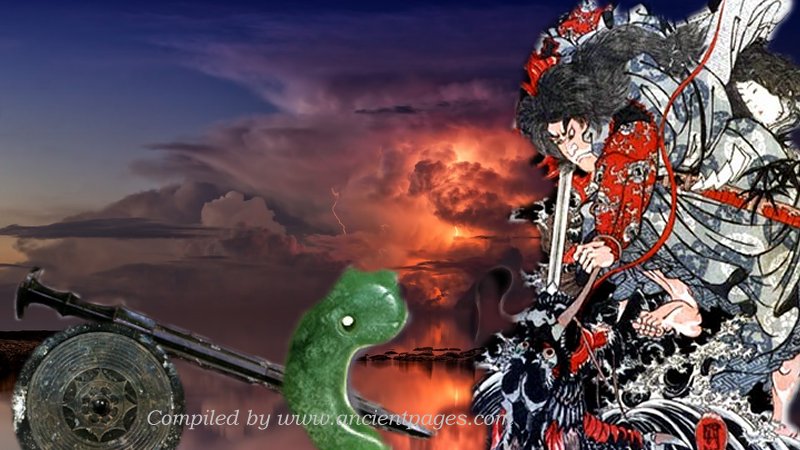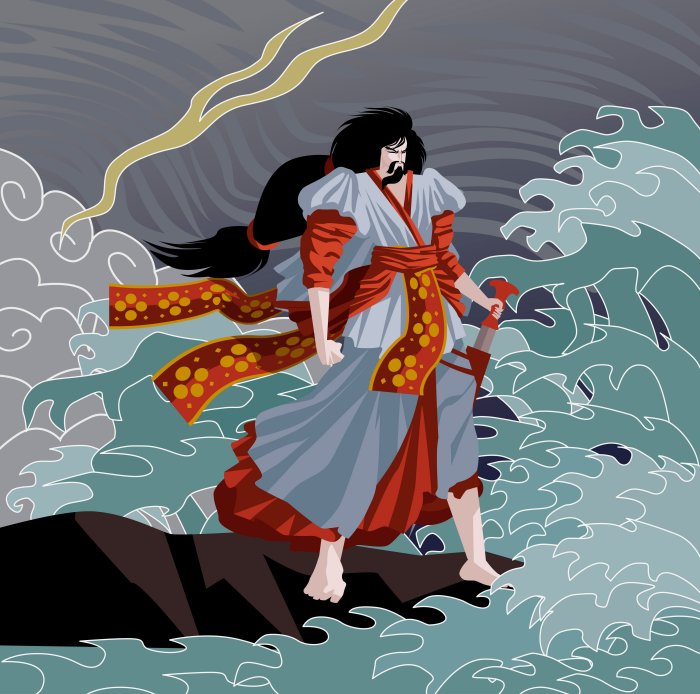Susanoo-no-Mikoto – Shinto God Of The Sea And Storms Was Banished From Heaven
David Tee - AncientPages.com - The earliest records anyone has of the Japanese myth Susanoo-no-Mikoto appears in the 8th century AD. These records tell the story of the Japanese storm and sea god who could not control himself when he got excited.
In fact, it was his uncontrollable nature that got him banned from heaven. Susanoo was born when his father, Izanagi, washed the remnants of the underworld off his body. Amaterasu was born when Izanagi washed out his left eye; her brother Tsukuyomi was born from washing of the right eye and Susanoo was born when Izanagi washed his nose.
How his sister was born, we do not know. But Susanoo’s banishment came when he could not control his temper. Like some gods, Susanoo had a favorite weapon, the Kusanagi sword that was one of three Imperial Regalia of Japan.
Lose Your Temper, Lose Heaven
Susanoo and his sister Amaterasu decided to have a little competition with each other. They decided to see who could create gods, and then they would decide who won the competition. Susanoo decided that he won because his object created women. His sister agreed and for a time the two lived very contentedly.
But this quiet scenario was not going to last. For some reason, Susanoo lost his temper and went on a rampage, destroying his sister’s property and killing one of her maids. This made Amaterasu very afraid, and she hid in a cave.
Susanoo-no-Mikoto with the Kusanagi sword. Credit: Adobe Stock - matiasdelcarmine
Amaterasu was the sun goddess, and the world was plunged into darkness when she hid herself. It was a situation that could only be remedied by drawing her out of her hiding place. For his actions, Sosanoo was banished from heaven.
Different accounts have this event at different times.
Susanoo-no-Mikoto And The Three Regalia
The three imperial regalia of Japan are revered items that are housed in different shrines throughout the country. They have been used to guide the nation into modern times and turn feudal Japan into a modern country.
It is said that the three imperial regalia were a direct gift from Amaterasu to the people of Japan. How did Amaterasu come to possess the three imperial regalia? During her time hiding in the cave, the gods needed to draw her out so that the sun would shine again.
They got together and decided to give her jewels and a mirror. Then, the goddess Uzume started to take her clothes off. The idea of this dance made the other gods laugh loudly. This piqued Amaterasu curiosity, who wondered why they could be celebrating.
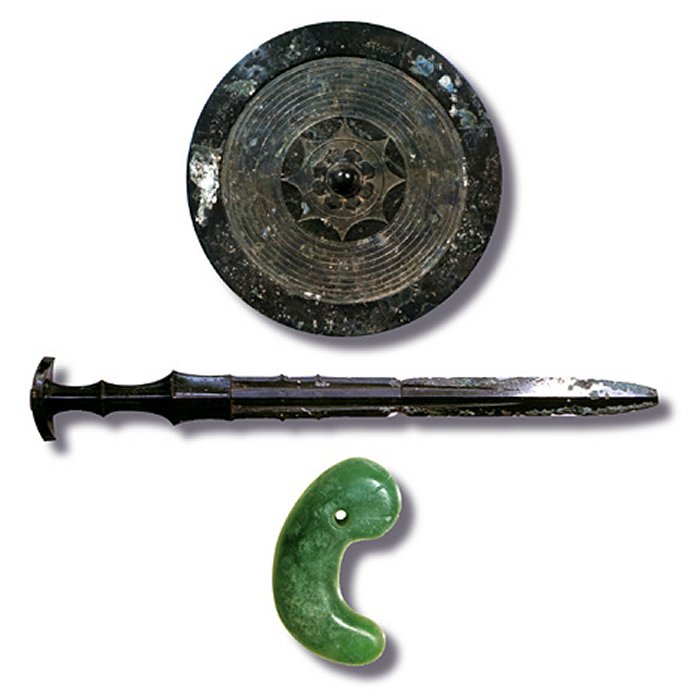
Artist's impressions of the (unseen) Imperial Regalia of Japan. Image credit Wikipedia - CC BY-SA 4.0
Once she opened the blocked cave, the other gods dragged her out of hiding. A third gift, the sword Kusanagi no tsurugi, was given by Sosanoo as an apology. He was sorry by what he did and tried to make it up to his sister by giving this sword he had taken from an earthly monster.
These three items make up the three imperial regalia.
One Of Susanoo's Adventures
Once on earth, Susanoo was not lacking adventure or challenges. One challenge came when he met some Japanese villagers who told them a monster had devoured some of the children from the village.
The monster was an eight-headed serpent who covered 8 hills and 8 valleys with his large body. Susanoo did not meet the serpent head on but decided to use a little trickery. He had the villagers prepare 8 large vats of sake and when ready, Susanoo placed those vats in the path of the serpent.
Each head of the serpent drank from their own vat. Once consumed, all eight heads fell asleep. Susanoo then took his sword and cut the eight heads off. He then proceeded to the tails and saw that inside one of the tails was the sword Kusanagi no tsurugi.
This was the sword that Susanoo gave to his sister in apology and which became one of the three imperial regalia of Japan.
Susanoo-no-Mikoto Is Still Thought Of Today
Both Susanoo and his sister, Amaterasu are housed in temples today, they are not placed together. Amaterasu was placed in the Honden Shrine or "Grand Shrine, while Susanoo was housed in the Kumano Taisha located in Shimane.
That was the place it is said that he descended to earth.
Updated on March 3, 2024
Written by – David Tee AncientPages.com Staff Writer
Copyright © AncientPages.com All rights reserved. This material may not be published, broadcast, rewritten or redistributed in whole or part without the express written permission of AncientPages.com
Expand for referencesMore From Ancient Pages
-
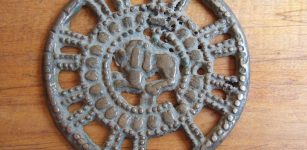 “Thogcha” – Thousand-Year-Old Tibetan Amulets And The Bon Culture
Ancient Technology | Dec 11, 2021
“Thogcha” – Thousand-Year-Old Tibetan Amulets And The Bon Culture
Ancient Technology | Dec 11, 2021 -
 Tribe Recalls Ancient Contact With An Extraterrestrial In The Amazon Jungle And A Strange Beam Of Light
Featured Stories | Jun 25, 2020
Tribe Recalls Ancient Contact With An Extraterrestrial In The Amazon Jungle And A Strange Beam Of Light
Featured Stories | Jun 25, 2020 -
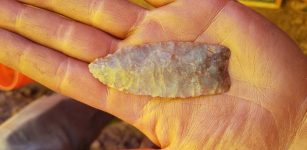 Evidence Americas’ Oldest Mine In Wyoming Was Used By Paleoindians 13,000 Years Ago Has Been Found!
Archaeology | May 19, 2022
Evidence Americas’ Oldest Mine In Wyoming Was Used By Paleoindians 13,000 Years Ago Has Been Found!
Archaeology | May 19, 2022 -
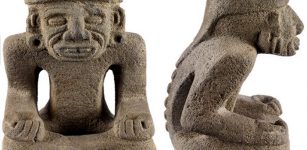 Huehueteotl: Old Aztec God Of Fire, Time And Aging – Ceremony Of The New Fire
Aztec Mythology | Jan 31, 2019
Huehueteotl: Old Aztec God Of Fire, Time And Aging – Ceremony Of The New Fire
Aztec Mythology | Jan 31, 2019 -
 Rosicrucian Secret That Was Never Meant To Be Revealed
Featured Stories | Apr 18, 2018
Rosicrucian Secret That Was Never Meant To Be Revealed
Featured Stories | Apr 18, 2018 -
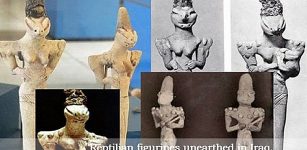 The Mystery Of The Serpent Seed
Biblical Mysteries | Jul 19, 2019
The Mystery Of The Serpent Seed
Biblical Mysteries | Jul 19, 2019 -
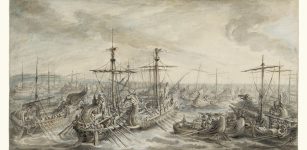 Battle Of Cape Ecnomus: One Of The Greatest Naval Battles In History
Ancient History Facts | Jun 17, 2019
Battle Of Cape Ecnomus: One Of The Greatest Naval Battles In History
Ancient History Facts | Jun 17, 2019 -
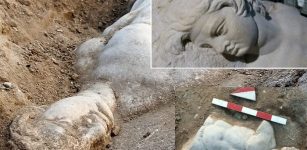 1,800-Year-Old Relief Of Mythological Satyr Figure Under Restoration
Artifacts | Sep 5, 2020
1,800-Year-Old Relief Of Mythological Satyr Figure Under Restoration
Artifacts | Sep 5, 2020 -
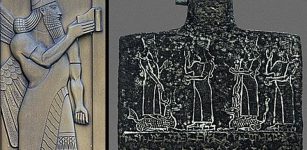 Mesopotamian God Nabu Inscribed The Human Fates Determined By The Gods
Featured Stories | Aug 7, 2018
Mesopotamian God Nabu Inscribed The Human Fates Determined By The Gods
Featured Stories | Aug 7, 2018 -
 Evolution Might Stop Humans From Solving Climate Change – Researchers Say
Evolution | Jan 3, 2024
Evolution Might Stop Humans From Solving Climate Change – Researchers Say
Evolution | Jan 3, 2024 -
 Mysterious Ancient Village In A Prehistoric Anomalous Zone – Unexplained Sightings And Sounds – Part 1
Featured Stories | Jul 27, 2020
Mysterious Ancient Village In A Prehistoric Anomalous Zone – Unexplained Sightings And Sounds – Part 1
Featured Stories | Jul 27, 2020 -
 Evidence Of Legendary Ancient Great Flood In China May Re-Write History
Chinese Mythology | Aug 5, 2016
Evidence Of Legendary Ancient Great Flood In China May Re-Write History
Chinese Mythology | Aug 5, 2016 -
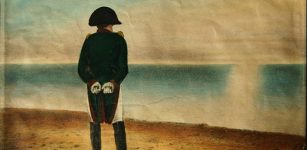 On This Day In History: Napoleon Exiled To Elba – On Apr 11, 1814
News | Apr 11, 2016
On This Day In History: Napoleon Exiled To Elba – On Apr 11, 1814
News | Apr 11, 2016 -
 Ancient Race Of Star Worshippers And Secret Message Stored In Unusual Monument
Civilizations | Jun 11, 2018
Ancient Race Of Star Worshippers And Secret Message Stored In Unusual Monument
Civilizations | Jun 11, 2018 -
 Amazing Ancient Underwater Treasures And Temples Discovered At Thonis-Heracleion
Archaeology | Sep 20, 2023
Amazing Ancient Underwater Treasures And Temples Discovered At Thonis-Heracleion
Archaeology | Sep 20, 2023 -
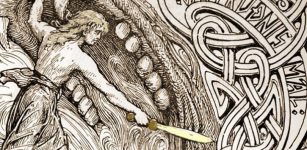 Fenrir Killed At Ragnarok By Vidar Who Avenged His Father Odin’s Death
Featured Stories | Dec 10, 2018
Fenrir Killed At Ragnarok By Vidar Who Avenged His Father Odin’s Death
Featured Stories | Dec 10, 2018 -
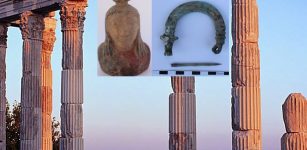 Excavations Reveal New Artifacts That Change History Of Ancient City Of Pergamon
Archaeology | Jul 4, 2020
Excavations Reveal New Artifacts That Change History Of Ancient City Of Pergamon
Archaeology | Jul 4, 2020 -
 Lazarus – An Obscure Biblical Figure
Biblical Mysteries | May 3, 2019
Lazarus – An Obscure Biblical Figure
Biblical Mysteries | May 3, 2019 -
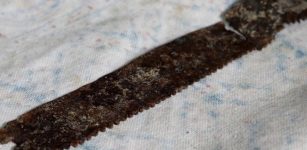 Rare 2,500-Year-Old Saw Discovered At The Ancient Hittite City Hattusa
Archaeology | Nov 27, 2023
Rare 2,500-Year-Old Saw Discovered At The Ancient Hittite City Hattusa
Archaeology | Nov 27, 2023 -
 Sumerian King List – Ancient Record Of Kingship That Has Long Been Of Great Interest
Artifacts | Jan 22, 2016
Sumerian King List – Ancient Record Of Kingship That Has Long Been Of Great Interest
Artifacts | Jan 22, 2016

